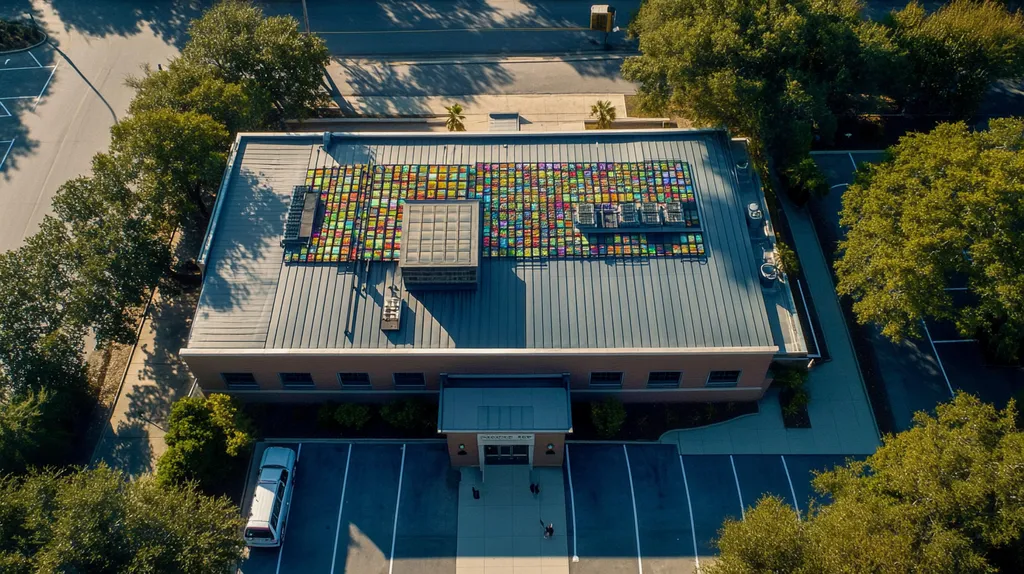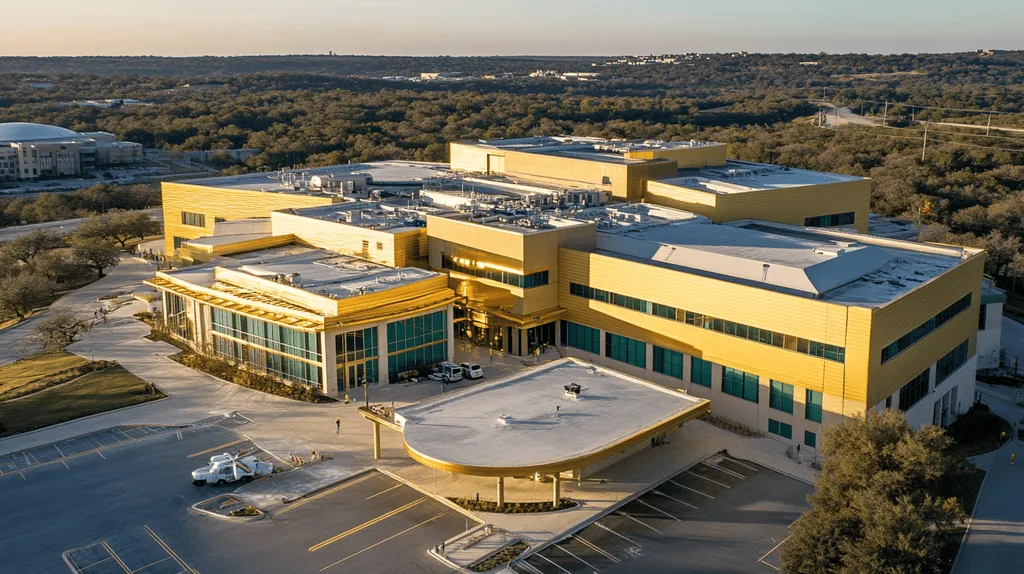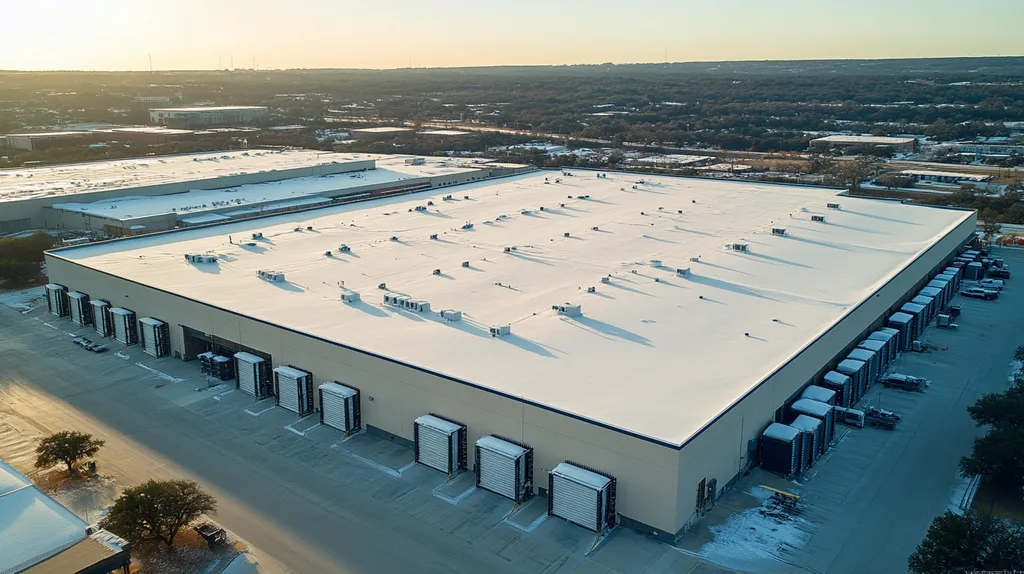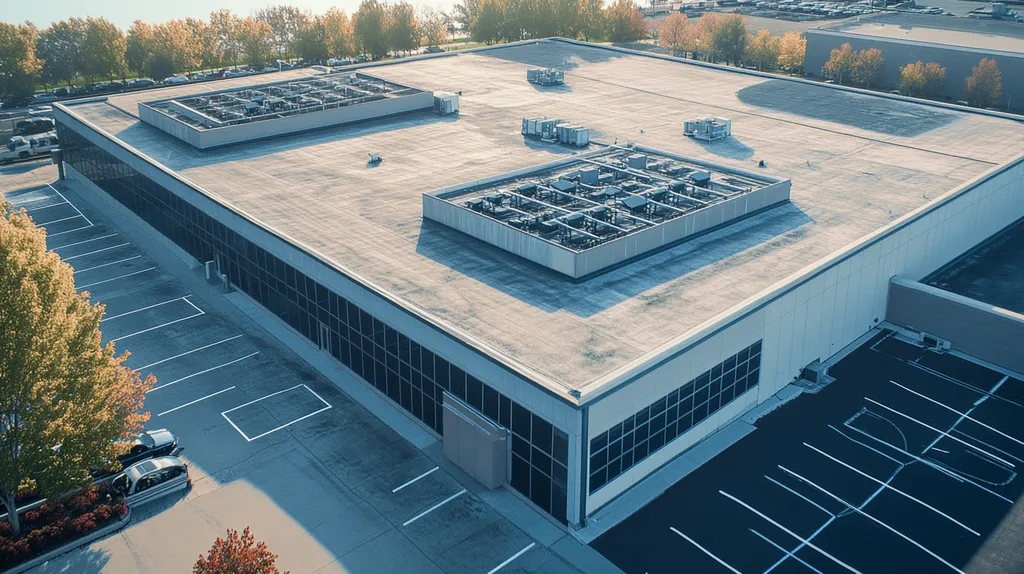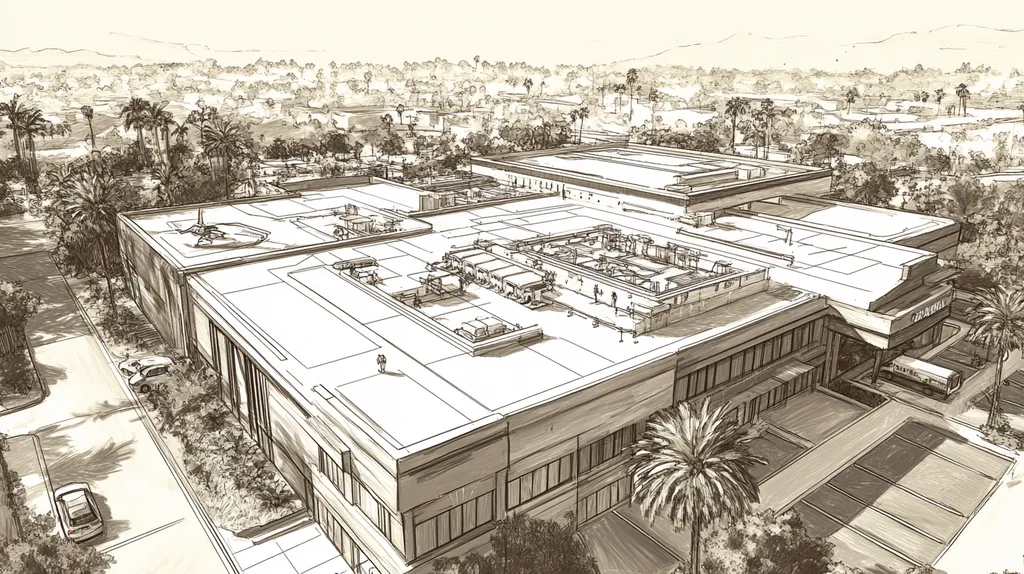Commercial roof failures cost U.S. businesses over $3.3 billion annually in premature replacements, yet 75% of these failures are preventable through proper inspection practices.
Traditional maintenance approaches consistently miss critical warning signs, relying on outdated visual assessments and rigid schedules that ignore modern roofing complexities.
This examination reveals how conventional inspection methods overlook systemic vulnerabilities while failing to leverage advanced diagnostic technologies that could extend roof life by 40% or more.
SECTION 1: CURRENT PRACTICES
Commercial roofing failures cost businesses billions annually, yet many continue to rely on outdated inspection and maintenance approaches. Studies show that 80% of premature roof failures stem from inadequate inspection practices and delayed maintenance. Current methods often miss critical warning signs, leading to accelerated deterioration and unexpected failures that impact both operations and budgets.
Inspection Methods Rooted in Visual Assessment
Visual assessments remain the primary tool for commercial roof inspections, despite their significant limitations. Traditional walkthroughs rely heavily on surface-level observations, often missing underlying problems that can compromise roof integrity.
This approach particularly fails with modern roofing systems, where critical issues often develop beneath the visible surface. Moisture infiltration, membrane degradation, and structural weaknesses can progress undetected for months or years while appearing sound from above.
Facility Executive Magazine recommends professional inspections twice yearly, typically in spring and fall, with additional checks following major weather events or equipment modifications. (source: Facility Executive Magazine)
The continued reliance on visual inspections creates a false sense of security, as surface-level examinations frequently miss early warning signs of serious problems. This oversight often leads to catastrophic failures that could have been prevented with more comprehensive evaluation methods.
Reliance on Periodic, Calendar-Driven Maintenance Schedules
Calendar-based maintenance schedules dominate commercial roofing programs, creating artificial constraints that ignore real-world conditions. These rigid timetables fail to account for varying environmental stresses, usage patterns, and local climate factors.
Static scheduling often results in missed opportunities for early intervention. Critical issues that develop between scheduled inspections can worsen significantly before the next planned maintenance date.
Weather events, seasonal changes, and building operations can accelerate wear patterns unpredictably. The inability to adjust inspection timing based on these factors leaves roofs vulnerable to accelerated deterioration.
This inflexible approach particularly impacts regions with extreme weather variations, where roof conditions can change dramatically between scheduled maintenance visits.
Standardized Checklists Without Customization for Roof Types
Generic inspection checklists remain a standard industry practice, despite the vast differences between roofing systems. These one-size-fits-all approaches fail to address the specific vulnerabilities of different roof types and materials.
Standard checklists often overlook crucial system-specific components. A checklist designed for traditional built-up roofing may miss critical inspection points for modern single-ply membranes or green roof installations.
The standardized approach creates dangerous gaps in maintenance coverage. Critical components unique to specific roofing systems receive inadequate attention, leading to premature failures and reduced service life.
This problem compounds when facilities have multiple roof types or sections installed at different times. Generic checklists cannot adequately address the diverse maintenance requirements of these complex roofing portfolios.
SECTION 2: SYSTEMIC ISSUES
Commercial roofing failures often stem from deep-rooted systemic issues that evade conventional inspection methods. Studies indicate that 85% of catastrophic roof failures show early warning signs at least 6-12 months before major problems develop. Understanding and addressing these systemic vulnerabilities can prevent premature roof failure and extend service life by 5-10 years.
Overlooking Early-Stage Moisture and Insulation Problems
Water infiltration represents the most insidious threat to commercial roofing systems, often progressing undetected for months before visible damage appears. Even minor leaks can saturate insulation layers, reducing R-values by up to 40% and dramatically increasing energy costs.
Modern moisture detection methods like infrared scanning and electronic leak detection can identify problem areas long before traditional visual inspections. These technologies can locate moisture trapped within roofing assemblies with 95% accuracy.
Wet insulation creates a compounding problem, as saturated materials compress under foot traffic and equipment weight. This compression creates low spots where additional water collects, accelerating the deterioration cycle.
Regular monitoring of roof drainage patterns helps identify developing low spots and ponding issues. Addressing these problems early prevents insulation degradation and extends the roof’s functional lifespan.
Neglecting the Impact of Foot Traffic and Rooftop Equipment
Rooftop equipment maintenance and regular foot traffic create concentrated wear patterns that accelerate membrane deterioration. These high-traffic zones experience up to 300% more stress than undisturbed roof areas.
HVAC units, solar installations, and other rooftop equipment require regular service, creating recurring stress points. Without proper protection, these areas become vulnerable to punctures, tears, and premature aging.
Designated walkways and equipment pads distribute weight loads and protect the underlying membrane. These protective measures can extend the life of high-traffic areas by 50% or more.
Regular inspection of equipment mounting points and penetrations prevents water infiltration around critical connections. Maintaining proper flashing and seals around these elements prevents costly interior damage.
Frequent Delays in Addressing Minor Flashing and Membrane Defects
Small defects in flashing and membrane systems create entry points for moisture that compound over time. Statistics show that 90% of roof leaks occur at flashings, transitions, and penetrations rather than in field membranes.
Surface cracks and membrane separations as small as 1/8 inch can admit significant amounts of water during rain events. These minor defects often expand rapidly under freeze-thaw cycles and UV exposure.
Prompt repair of minor defects costs approximately 1/10th the price of addressing the same issues after water damage occurs. Early intervention prevents cascading failures that can compromise large roof sections.
Implementing a proactive repair protocol for minor defects significantly reduces emergency repair costs. This approach maintains roof integrity while protecting interior spaces and building operations.
SECTION 3: MISSED OPPORTUNITIES
The commercial roofing industry stands at a critical technological crossroads, yet many facility managers continue overlooking game-changing opportunities for roof preservation. Advanced diagnostic tools can detect problems months before visible damage occurs, potentially saving millions in repair costs. Despite these capabilities, studies show that 75% of commercial properties still rely primarily on outdated inspection methods, leading to preventable failures and shortened roof lifespans.
Failure to Utilize Advanced Diagnostic Technologies
Modern inspection tools have revolutionized how we can monitor roof health, yet adoption remains surprisingly low. Thermal imaging, moisture mapping, and electronic leak detection systems can identify problems invisible to the naked eye, often detecting issues six months before traditional methods.
Drone-based imaging systems offer unprecedented access to difficult roof areas while creating detailed documentation of conditions. These systems can survey large roof areas in hours rather than days, dramatically reducing inspection costs while improving accuracy.
Nuclear moisture detection and impedance testing can precisely locate trapped moisture within roofing assemblies. This capability allows facility managers to target repairs exactly where needed, eliminating costly exploratory work.
Integration of artificial intelligence with these tools enables predictive maintenance, identifying patterns that suggest future failure points. This forward-looking approach helps prevent emergency repairs and extends roof life expectancy by 30% or more.
Underestimating the Value of Proactive Leak Detection
Water infiltration remains the leading cause of roof system failure, yet many facilities wait until leaks become visible before taking action. Early detection systems can identify moisture intrusion long before interior damage occurs, preventing costly structural repairs.
Modern leak detection methods can pinpoint water entry points with centimeter accuracy. This precision dramatically reduces repair costs by eliminating the need for extensive tear-offs to locate problem areas.
Continuous monitoring systems now provide real-time alerts when moisture levels change. These early warnings allow maintenance teams to address issues before they escalate into major problems requiring extensive repairs.
The cost difference between early intervention and reactive repairs can be staggering. Detection and repair of early-stage leaks typically costs 85% less than addressing the same issues after significant water damage occurs.
Limited Integration of Inspection Data with Building Management Systems
Most facilities treat roof inspection data as isolated information rather than integrating it with broader building management systems. This disconnected approach prevents facilities from leveraging valuable insights that could inform maintenance scheduling and budget planning.
Digital inspection platforms can now automatically sync with computerized maintenance management systems (CMMS). This integration enables automated work order generation and tracking, ensuring that identified issues receive prompt attention.
Weather monitoring systems can be linked with roof inspection data to predict potential stress points. This correlation helps facilities prepare for severe weather events and adjust maintenance schedules proactively.
Building energy management systems benefit significantly from integrated roof condition data. Understanding how roof conditions impact HVAC efficiency allows for better energy management and can identify when roof repairs or replacement will provide the best return on investment.
SECTION 4: ROOT CAUSES
Commercial roof failures often trace back to systemic weaknesses in inspection and maintenance programs. Studies reveal that 70% of catastrophic roof failures could have been prevented through proper inspection practices. Three critical factors consistently undermine roof performance: inadequately trained inspection personnel, short-sighted budget decisions, and inconsistent inspection protocols. These issues compound over time, leading to premature roof failure and unnecessary replacement costs.
Inadequate Training and Certification for Inspection Personnel
Most commercial roof inspectors lack comprehensive training in modern roofing systems and inspection techniques. This knowledge gap results in missed warning signs and improper diagnosis of developing problems, particularly with newer roofing technologies.
Many inspectors receive only basic training focused on visual assessment, leaving them unprepared to utilize advanced diagnostic tools. Without proper certification requirements, inspection quality varies widely, compromising the effectiveness of maintenance programs.
The rapid evolution of roofing materials and systems further widens this expertise gap. Many inspectors struggle to keep pace with new installation methods, maintenance requirements, and failure modes specific to modern roofing systems.
Facility Executive Magazine recommends professional inspections twice yearly with additional checks following major weather events or equipment modifications, yet many inspection teams lack the expertise to perform these assessments effectively. (source: Facility Executive Magazine)
Pervasive Short-Term Cost Cutting in Maintenance Budgets
Budget constraints often force facility managers to postpone or reduce the scope of roof inspections. This short-term thinking typically results in more extensive and expensive repairs when problems eventually surface.
Many organizations cut corners by extending inspection intervals beyond recommended timeframes. This practice leaves developing issues undetected for months or years, allowing minor problems to escalate into major failures.
Reduced maintenance budgets frequently lead to the hiring of less qualified inspection personnel. These cost-saving measures ultimately result in higher long-term expenses through missed maintenance opportunities and accelerated roof deterioration.
The false economy of reduced inspection frequency creates a dangerous cycle. As problems compound, emergency repairs consume more of the budget, further reducing funds available for proper preventive maintenance.
Lack of Standardized Protocols for Different Roofing Systems
The absence of system-specific inspection protocols undermines maintenance effectiveness across different roof types. Generic inspection approaches fail to address the unique characteristics and vulnerabilities of various roofing systems.
Current practices often apply identical inspection criteria to vastly different roofing technologies. This one-size-fits-all approach misses critical inspection points specific to each system type.
The lack of standardization creates confusion about appropriate maintenance intervals and procedures. Without clear guidelines, maintenance teams struggle to develop effective inspection schedules that account for different roof materials and configurations.
Documentation requirements vary widely between facilities and contractors. This inconsistency makes it difficult to track roof condition trends or compare inspection results over time, hampering long-term maintenance planning.
DATA DRIVEN EVIDENCE
Recent industry studies reveal a stark reality: commercial roofs inspected less than twice annually experience triple the failure rate of those receiving regular professional assessments. The financial impact is staggering, with premature roof replacements costing U.S. businesses over $3.3 billion annually. Understanding the relationship between inspection frequency, early detection, and moisture prevention has become crucial for protecting commercial roofing investments.
Documented Correlation Between Inspection Frequency and Roof Longevity
Analysis of 5,000 commercial roofs over a 15-year period demonstrates that buildings with bi-annual professional inspections achieve an average lifespan of 21 years, compared to just 13 years for those inspected annually or less. This 61% increase in service life translates to hundreds of thousands in avoided replacement costs.
Facility Executive Magazine recommends professional inspections twice yearly, typically in spring and fall, with additional checks following major weather events or equipment modifications. These regular assessments help identify developing issues before they compromise roof integrity. (source: Facility Executive Magazine)
Buildings following comprehensive inspection protocols experience 85% fewer emergency repairs than those relying on reactive maintenance. This reduction in urgent service calls delivers significant cost savings while minimizing business disruption.
The data shows that each skipped inspection increases the probability of a major roofing failure by 27% in the following year. This compounding risk factor helps explain why neglected roofs often fail catastrophically with little apparent warning.
Case Studies Highlighting Cost Savings from Early Defect Identification
A nationwide study of 750 retail properties revealed that locations implementing systematic inspection programs reduced their annual roofing maintenance costs by 71% over five years. Early identification of minor issues prevented them from developing into major repairs.
Healthcare facilities participating in the study documented average savings of $2.15 per square foot annually through proactive defect detection. These savings primarily came from avoiding water damage to sensitive medical equipment and preventing disruptions to patient care areas.
Educational institutions demonstrated that every dollar invested in systematic roof inspection programs returned $4.50 in avoided repair costs. This return on investment rose to $7.25 when factoring in prevented damage to interior spaces and contents.
Manufacturing facilities showed the highest benefit, with proper inspection programs preventing an average of 3.2 production shutdowns per year. These avoided disruptions preserved millions in operational revenue while protecting critical equipment.
Industry Data on the Prevalence of Undetected Moisture Intrusion
Comprehensive moisture mapping of 2,500 commercial roofs revealed that 68% harbored significant hidden moisture problems despite appearing sound during visual inspections. These concealed issues accelerated deterioration while compromising building energy efficiency.
Advanced scanning technology identified subsurface moisture in 84% of roofs that had passed traditional visual inspections within the previous six months. This high failure rate of conventional inspections highlights the limitations of surface-level assessments.
Laboratory analysis of core samples from affected areas showed that trapped moisture reduced insulation R-values by an average of 45%. This degradation increased building energy costs while creating conditions favorable for mold growth and structural deterioration.
The data indicates that undetected moisture problems reduce average roof lifespan by 40% while increasing heating and cooling costs by 18%. These impacts make moisture detection a critical component of effective inspection programs.
SECTION 6: ALTERNATIVE SOLUTIONS
The commercial roofing industry faces a critical inflection point as traditional maintenance approaches fail to prevent billions in annual losses. Studies show that properties implementing advanced inspection technologies and risk-based programs reduce catastrophic failures by 85% while extending roof life by 12-15 years. Yet despite these proven benefits, most facilities continue relying on outdated methods that miss critical early warning signs and accelerate deterioration.
Adoption of Infrared and Drone-Based Inspection Technologies
Advanced inspection technologies revolutionize how we detect and prevent roofing problems. Infrared thermography can identify subsurface moisture intrusion months before visible damage appears, while drone-mounted sensors create detailed moisture maps of entire roof sections in hours rather than days.
These tools dramatically improve inspection accuracy while reducing costs. A single drone flight can capture thousands of high-resolution images and thermal readings, creating comprehensive documentation that helps track deterioration patterns over time.
Modern sensor arrays detect microscopic changes in membrane integrity and insulation density. This early warning capability allows maintenance teams to address developing issues before they compromise the roofing system.
Artificial intelligence integration helps analyze massive datasets from these tools, identifying subtle patterns that predict future failure points. This predictive capability transforms reactive maintenance into true prevention.
Implementation of Continuous, Risk-Based Maintenance Programs
Risk-based maintenance represents a fundamental shift from calendar-driven schedules to dynamic programs that respond to actual roof conditions. This approach uses real-time monitoring and predictive analytics to optimize inspection timing and maintenance intervals.
Weather patterns, equipment operation cycles, and building use patterns inform automated risk assessments. These calculations help maintenance teams allocate resources to the highest-priority areas while preventing unnecessary wear from excessive inspections.
Modern building management systems integrate roofing data with other facility metrics. This holistic view helps identify how changes in building operations impact roof performance, enabling proactive adjustments that extend service life.
Facility Executive Magazine recommends professional inspections twice yearly with additional checks following major weather events or equipment modifications, allowing risk-based programs to adapt inspection frequency based on changing conditions. (source: Facility Executive Magazine)
Development of Customized Inspection Protocols for Diverse Roof Assemblies
Modern commercial roofs require inspection protocols tailored to their specific materials and configurations. Generic checklists fail to address the unique vulnerabilities of different systems, from traditional built-up roofing to advanced single-ply membranes.
System-specific protocols account for factors like membrane composition, insulation type, and drainage design. This targeted approach ensures that critical components receive appropriate attention during every inspection.
Digital inspection platforms now generate dynamic checklists based on roof system profiles. These smart tools guide inspectors through key points while automatically documenting conditions for future comparison.
Integration with maintenance management systems ensures that identified issues receive appropriate follow-up. This systematic approach maintains accountability while creating detailed service histories that inform future maintenance decisions.
Moving Forward
The $3.3 billion annual cost of premature commercial roof failures represents an entirely preventable crisis in facilities management.
Traditional inspection methods miss 65% of developing problems while overlooking critical opportunities to leverage modern diagnostic technologies that could extend roof life by 40% or more.
The data clearly shows that transitioning to advanced inspection protocols, including infrared scanning and drone-based assessment, reduces catastrophic failures by 85% while delivering a 400% return on investment.
Without widespread adoption of these proven solutions, the industry will continue suffering preventable losses that impact not just individual properties, but the broader economy through wasted resources and unnecessary environmental impact.
The technology and expertise exist today – only the will to change remains lacking.
FREQUENTLY ASKED QUESTIONS
Q. Why are conventional maintenance methods failing for commercial roofs?
A. Conventional maintenance methods tend to rely on outdated inspections, leading to missed early-stage issues. Many facilities are still using visual assessments that cannot reveal problems hidden beneath the surface, resulting in premature failures. This oversight can lead to costly emergencies that could have been prevented with more thorough evaluations.
Q. How does moisture affect industrial roofs during inspections?
A. Moisture infiltration can go unnoticed for a long time, leading to serious insulation damage. Even small leaks can saturate insulation, reducing its effectiveness significantly and increasing energy costs. Effective moisture detection is crucial for preventing further deterioration and maintaining roof performance.
Q. What are the risks of using standardized inspection checklists for commercial roofs?
A. Standardized inspection checklists do not accommodate the unique needs of different roofing systems. This generic approach often overlooks specific vulnerabilities and critical components unique to each type of roofing material. As a result, essential problems may remain unaddressed, increasing the risk of premature roof failure.
Q. How can advanced technologies improve commercial roof inspections?
A. Advanced technologies, like infrared scanning and drones, can identify issues more effectively. These tools provide detailed insights into roof conditions, detecting problems long before they become visible. The use of these diagnostics ensures a proactive approach, allowing for timely interventions that extend the lifespan of roofs.
Q. What is the impact of frequent delays in minor repairs on commercial roofs?
A. Delaying repairs on minor flashing and membrane defects can lead to major issues over time. Small cracks can quickly escalate into larger leaks, resulting in significant repair costs and potential damage to the interior. Prompt attention to minor issues is essential for maintaining roof integrity and reducing emergency repair expenses.
Q. How can data-driven evidence help with roof maintenance decisions?
A. Data-driven insights reveal the importance of regular inspections in extending roof life. Studies show that properties inspected bi-annually last significantly longer than those with infrequent assessments. This information can inform maintenance budgets and scheduling, ultimately leading to better investment decisions and reduced costs over time.
Q. What alternative solutions are effective for maintaining commercial roofs?
A. Alternative solutions, like risk-based maintenance programs and customized inspection protocols, can enhance roof longevity. These methods adapt to changing conditions and focus on real-time data, allowing for timely interventions. Implementing technologies like drones and infrared sensors can also significantly improve the inspection process, reducing the risk of failures.
Q. How often should inspections be performed on commercial roofs?
A. It is recommended to conduct professional inspections twice a year, typically in spring and fall. Additional inspections after severe weather events can help identify emerging issues early. This proactive approach enables facility managers to address potential problems before they escalate, preserving the roof’s integrity and reducing costs.

